 AUSTRALIA
AFTER DARK (1975)
AUSTRALIA
AFTER DARK (1975)Director: John D. Lamond
Intervision Picture Corp.
 AUSTRALIA
AFTER DARK (1975)
AUSTRALIA
AFTER DARK (1975)FELICITY director John D. Lamond travels behind and beyond Australia’s strip-clubs and gentlemen’s clubs to show us the real AUSTRALIA AFTER DARK.
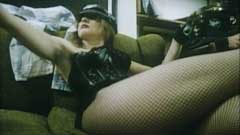
Opening in the salon of Madame Lash (aka Gretel Pinninger), a disciple of the Marquis de Sade and VENUS IN FURS author Leopold Von Sachar-Masoch, from whose name the term “masochism” is derived, the film cuts away once it has flashed some leather and a bit of frontal nudity – possibly still treading the waters of the Australian R “Restricted Exhibition” rating introduced in 1971 – to studios where men can rent nude models to paint and create living works of art. After a detour to explore ancient rock art, we head back to the studio of Sir John Sulman prize winner Wes Penberthy, who also paints his models before dragging them across giant canvases to create living murals choreographed to classical music. A visit to the Melbourne Gaol gallows shows us a more morbid art style: the death masks of noted criminals including Ned Kelly and a British émigré believed to be the real Jack the Ripper. Things get lighter with a visit to Alice Springs where the locals conduct “dehydrated regattas” (while drinking enough beer to float a boat), and then to the Gold Coast where designer Barry Goodwill custom fits bikinis (which requires the “intricate skill of a watchmaker and the eye of a birdwatcher”). Beach-goers who prefer all-over tans head on over to Daydream Island where bikinis are formal wear. The more sober look at alcoholism among the aborigines, “stone aged men […] rushed into the twentieth century” drinking to “forget memories of the Dreamtime.” Alcoholism among the white residents of the Northern territories – estimated at fifty-two gallons per person per year – is handled more lightly (and why shouldn’t it, they got Guinness world record for the longest bar).
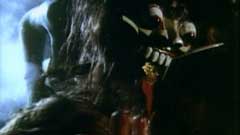 White
witch Eddie Pielk seeks to free topless inductees from the mental prisons of
Christianity, but things get more salacious with a Norman J. Warren-esque Black
Mass in the woods under the full moon, which includes naked witches and a green-skinned
Satan. How can you out- weird that? Why not a trip to the “very gay city”
of Perth where the Reverend Mario Schoenmaker presides over the union of two
long-haired, somewhat androgynous-looking blokes in biker gear; Schoenmacker
– purportedly a gifted clairvoyant as well – did indeed conduct
the first gay marriage in Perth in 1973. Somehow homosexuals and transsexuals
(a Gypsy Rose Lee-esque stripper with a little something extra) transitions
to the 1966 saucer invasions in Tully, Queensland as documented by Claire Noble,
who believes that the likeness of Trobriand gods are actually extraterrestrial
visitors who stop by to collect resources from Earth. The Daily Planet is not
the work place of Superman; rather, it is an exclusive gentleman’s club
where work-weary gents can get the hot oil treatment from naked chicks. Next,
we visit the studio of stag film producer George Schwartz, seen here instructing
two performers to gyrate to the rhythm of a musical toilet paper roll. Performance
artist Count Copernicus and his troupe strive for the provocative. Copernicus
fellates a banana while a topless female stokes a handgun and his clown band
wear signs sporting malapropisms like “God Speeds” and “Jesus
Shaves.”
White
witch Eddie Pielk seeks to free topless inductees from the mental prisons of
Christianity, but things get more salacious with a Norman J. Warren-esque Black
Mass in the woods under the full moon, which includes naked witches and a green-skinned
Satan. How can you out- weird that? Why not a trip to the “very gay city”
of Perth where the Reverend Mario Schoenmaker presides over the union of two
long-haired, somewhat androgynous-looking blokes in biker gear; Schoenmacker
– purportedly a gifted clairvoyant as well – did indeed conduct
the first gay marriage in Perth in 1973. Somehow homosexuals and transsexuals
(a Gypsy Rose Lee-esque stripper with a little something extra) transitions
to the 1966 saucer invasions in Tully, Queensland as documented by Claire Noble,
who believes that the likeness of Trobriand gods are actually extraterrestrial
visitors who stop by to collect resources from Earth. The Daily Planet is not
the work place of Superman; rather, it is an exclusive gentleman’s club
where work-weary gents can get the hot oil treatment from naked chicks. Next,
we visit the studio of stag film producer George Schwartz, seen here instructing
two performers to gyrate to the rhythm of a musical toilet paper roll. Performance
artist Count Copernicus and his troupe strive for the provocative. Copernicus
fellates a banana while a topless female stokes a handgun and his clown band
wear signs sporting malapropisms like “God Speeds” and “Jesus
Shaves.”
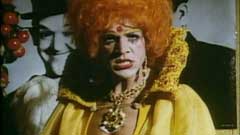
Despite a heap of nudity, AUSTRALIA AFTER DARK is rather tame by contemporary standards (or even in comparison to some of the other Australian films coming out around that period). Lamond’s definition of “after dark” is rather loose, combining the controversial (gay marriage, transsexual strippers, alcoholism among the aborigines as well as the whites in the Northern territories, pornography) with the weird (UFO sightings, the deathmasks, various fetishists, black magic) or the simply unconventional (the alternative community) or the exotic (aboriginal art, bikini culture, nude beaches), and some of the segments run a bit too long (particularly the UFO sighting and bum fetishist montage bits). The extended music video-like Count Copernicus sequence would have closed the film with a bang; however, Lamond finishes the film off with an extended bit with a nude Gina Allen diving among the tropical fish (photographed by NATIONAL GEOGRAPHIC cameraman Ben Cropp). The end result is more interesting as a historical document than as titillating exploitation (as the director himself admits now). Lamond’s grouping and ordering of subjects – witchcraft to gay marriage to pre-op transsexuals to aliens, for instance, or sticking displaced “stone age” aboriginals and alcoholism in between bottomless boat regattas and drinking contests – may be a tad questionable, but Lamond’s script (narrated by Dennis Gascoigne) is more politically incorrect than intentionally condescending or condemning. Producer Tim Burstall had previously directed a segment of the erotic anthology LIBIDO and later directed the psycho-thriller END PLAY and the period film ELIZA FRASER. The film was also the first of several feature collaborations between Lamond and cinematographer Garry Wapshott, and executive producer Alan Finney (now general manager of Buena Vista International) would collaborate with Lamond on the script for his follow-up THE ABCs OF LOVE AND SEX.
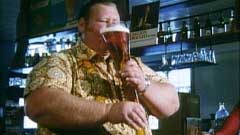 AUSTRALIA
AFTER DARK was released on DVD in Australia on a double feature DVD with THE
ABCs OF LOVE AND SEX by Umbrella Entertainment. This version was then reissued
as part of the six-disc THE OZ-PLOITATION BOX VOLUME 3 (with FELICITY, BARRY
McKENZIE HOLDS HIS OWN, MAD DOG MORGAN, PATRICK, and LES PATTERSON SAVES THE
WORLD). Sourced from an aged tape master, Intervision Picture Corp.’s
1.78:1 anamorphic disc of AUSTALIA AFTER DARK is somewhat painful on the eyes
(presumably the Umbrella disc was also sourced from a tape master as the specs
list is as being a 4:3 presentation). It seems as though 1.66:1 would have been
the better aspect ratio as the title card is clipped at the top, as are the
heads of actors in some long shots. The Dolby Digital mono audio is in good
condition (mainly comprised of narration and library music). The cut here represents
the R-rated version shown in cinemas – the Australian R-rating was considerably
more lenient than the U.S. R-rating of the time – and is one of the few
Lamond films to get through largely unmolested by the censors (in the commentary,
Lamond mentions that some films that were given R-ratings in the cinema were
sometimes cut down to receive and R-rating on videotape because salacious footage
could be paused and rewound). On the commentary track, Lamond avers to having
the master for a longer version with a never-released vignette, but offers no
explanation as to why it was not utilized here.
AUSTRALIA
AFTER DARK was released on DVD in Australia on a double feature DVD with THE
ABCs OF LOVE AND SEX by Umbrella Entertainment. This version was then reissued
as part of the six-disc THE OZ-PLOITATION BOX VOLUME 3 (with FELICITY, BARRY
McKENZIE HOLDS HIS OWN, MAD DOG MORGAN, PATRICK, and LES PATTERSON SAVES THE
WORLD). Sourced from an aged tape master, Intervision Picture Corp.’s
1.78:1 anamorphic disc of AUSTALIA AFTER DARK is somewhat painful on the eyes
(presumably the Umbrella disc was also sourced from a tape master as the specs
list is as being a 4:3 presentation). It seems as though 1.66:1 would have been
the better aspect ratio as the title card is clipped at the top, as are the
heads of actors in some long shots. The Dolby Digital mono audio is in good
condition (mainly comprised of narration and library music). The cut here represents
the R-rated version shown in cinemas – the Australian R-rating was considerably
more lenient than the U.S. R-rating of the time – and is one of the few
Lamond films to get through largely unmolested by the censors (in the commentary,
Lamond mentions that some films that were given R-ratings in the cinema were
sometimes cut down to receive and R-rating on videotape because salacious footage
could be paused and rewound). On the commentary track, Lamond avers to having
the master for a longer version with a never-released vignette, but offers no
explanation as to why it was not utilized here.
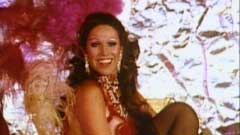 As
with Severin Films’ DVD of Lamond’s NIGHTMARES, Ozploitation documentary
NOT QUITE HOLLYWOOD director Mark Hartley prompts the director on a commentary
track exclusive to this release. Lamond reveals that the $50,000 (Australian
dollars) production was only possible because of Hexagon’s success with
ALVIN PURPLE and that it was very influenced by the Italian mondo films (including
Lamond’s choices of library music). He points out that the white witch
footage was real – Pielk composed the song “Turn Back the Times”
heard over the aborigine footage (the song was sung by Leonie Goodwin, who is
seen as one of Pielk’s inductees) – and the black mass was stage
(MAD MAX producer Byron Kennedy appears as one of the extras during this scene).
The mud fetishist was also a real person who let Lamond film her, while the
milk fetishist was a staged bit with actress Marilyn Rodgers (who later appeared
in THE ABCs OF LOVE AND SEX and FELICITY, as well as the long-running Australian
TV series PRISONER). Lamond mentions that the film was shot in 16mm and blown-up
to 35mm, and that he went to Sweden to have this work done after screening the
theatrical cut of Ingmar Berman’s 16mm-lensed miniseries SCENES FROM A
MARRIAGE. The back cover lists a “John Lamond Trailer Reel” –
presumably the one that appears on both the Umbrella and Severin DVDs of NIGHTMARES
– but it is not present as a menu option or as an Easter Egg. (Eric
Cotenas)
As
with Severin Films’ DVD of Lamond’s NIGHTMARES, Ozploitation documentary
NOT QUITE HOLLYWOOD director Mark Hartley prompts the director on a commentary
track exclusive to this release. Lamond reveals that the $50,000 (Australian
dollars) production was only possible because of Hexagon’s success with
ALVIN PURPLE and that it was very influenced by the Italian mondo films (including
Lamond’s choices of library music). He points out that the white witch
footage was real – Pielk composed the song “Turn Back the Times”
heard over the aborigine footage (the song was sung by Leonie Goodwin, who is
seen as one of Pielk’s inductees) – and the black mass was stage
(MAD MAX producer Byron Kennedy appears as one of the extras during this scene).
The mud fetishist was also a real person who let Lamond film her, while the
milk fetishist was a staged bit with actress Marilyn Rodgers (who later appeared
in THE ABCs OF LOVE AND SEX and FELICITY, as well as the long-running Australian
TV series PRISONER). Lamond mentions that the film was shot in 16mm and blown-up
to 35mm, and that he went to Sweden to have this work done after screening the
theatrical cut of Ingmar Berman’s 16mm-lensed miniseries SCENES FROM A
MARRIAGE. The back cover lists a “John Lamond Trailer Reel” –
presumably the one that appears on both the Umbrella and Severin DVDs of NIGHTMARES
– but it is not present as a menu option or as an Easter Egg. (Eric
Cotenas)